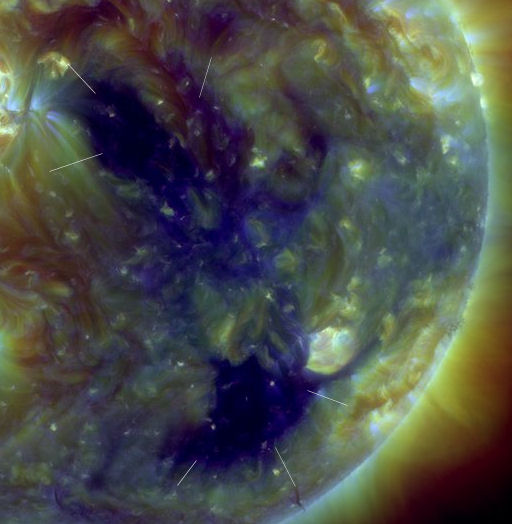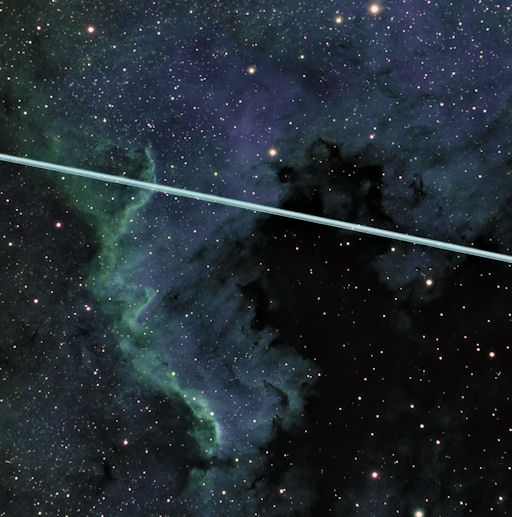Metallic photos of the sun by renowned photographer Greg Piepol bring together the best of art and science. Buy one or a whole set. They make a stellar gift. | | |
HOW BIG WAS THAT METEOR? Last week, a picture of a Perseid meteor taken from the International Space Station became a minor internet sensation. Researchers from the NASA Meteoroid Environment Office have analyzed the image to figure out how big was that meteor? Watch the latest video from Science@NASA for the answer.
DOUBLE CORONAL HOLE: A double-barreled hole has opened up in the sun's atmosphere and it is spewing a split-stream of solar wind toward Earth. NASA's Solar Dynamics Observatory captured this composite UV image of the double coronal hole on August 20th:

Sky watchers should be alert for auroras when the solar wind arrives on August 22-24. NOAA forecasters estimate a 35% to 50% chance of high-latitude geomagnetic activity. Aurora alerts: text, voice.
August 2011 Aurora Gallery
[previous Augusts: 2010, 2009, 2008, 2007, 2006, 2005, 2004, 2003, 2002]
SPACE STATION TRANSIT: "During an observing run on August 17th, I decided to to test a new guide camera by imaging the North America Nebula (NGC7000)," says Nick Howes of Cherhill, Wiltshire , UK. "Just then the ISS decided to fly right through my image!" (continued below)

It might sound like an incredible stroke of luck to catch the ISS crossing an interstellar cloud, but this week the odds are tilted in some observers' favor. In Europe, the space station is passing overhead as often as three times each night, crossing stars, planets, and distant nebulae as it slides silently from horizon to horizon over and over again. If you live in that part of the world, check the Simple Satellite Tracker for flyby times; an incredible stroke of luck could be in the offing.
more images: from Jan Koeman of Middelburg, the Netherlands; from Efrain Morales Rivera of Aguadilla, Puerto Rico; from Stefano De Rosa of Isola d' Elba (Italy)
2011 Noctilucent Cloud Gallery
[previous years: 2003, 2004, 2005, 2006, 2007, 2008, 2009]
Potentially Hazardous Asteroids (
PHAs) are space rocks larger than approximately 100m that can come closer to Earth than 0.05 AU. None of the known PHAs is on a collision course with our planet, although astronomers are finding
new ones all the time.
On August 20, 2011 there were 1241 potentially hazardous asteroids.
Notes: LD means "Lunar Distance." 1 LD = 384,401 km, the distance between Earth and the Moon. 1 LD also equals 0.00256 AU. MAG is the visual magnitude of the asteroid on the date of closest approach. | | The official U.S. government space weather bureau |
| | The first place to look for information about sundogs, pillars, rainbows and related phenomena. |
| | Researchers call it a "Hubble for the sun." SDO is the most advanced solar observatory ever. |
| | 3D views of the sun from NASA's Solar and Terrestrial Relations Observatory |
| | Realtime and archival images of the Sun from SOHO. |
| | from the NOAA Space Environment Center |
| | the underlying science of space weather |
| | for out-of-this-world printing and graphics |

